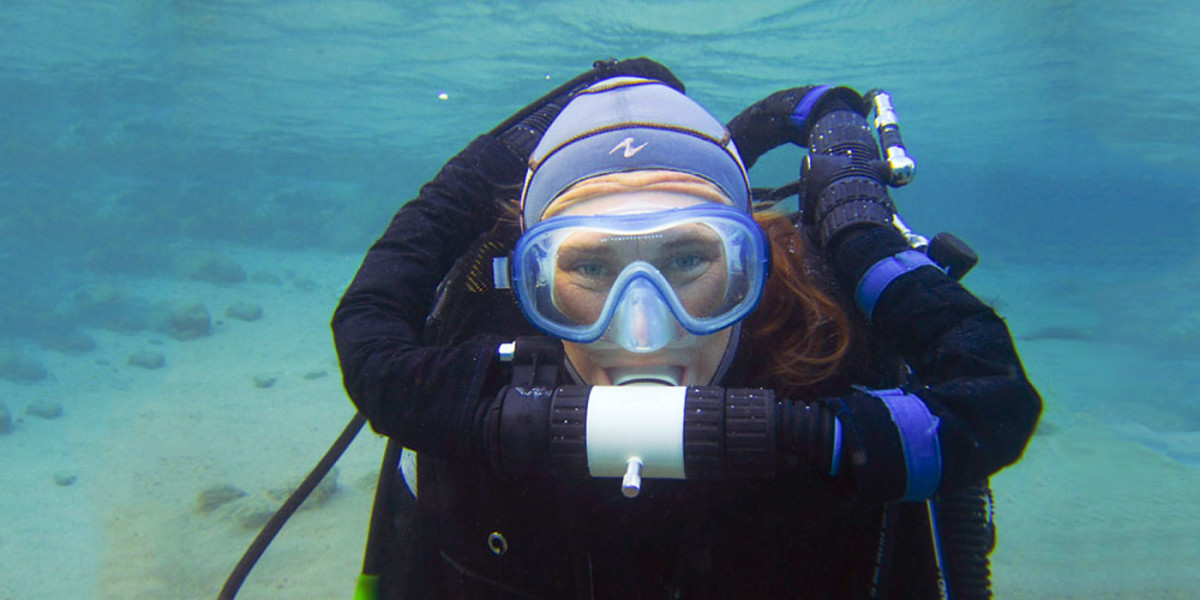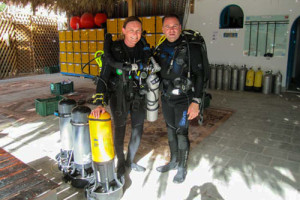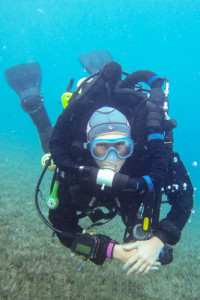In my last blog I told you about my first ever intro using a closed circuit rebreather (CCR) when I was a newly qualified instructor.
Fast forward several years and along comes Lee. Lee has been diving on a CCR (closed circuit rebreather to give them their proper names) for 8 years. He turned up with Scott, the diver I was planning to do Wagners Cave with (more about that in the future), who had just bought a rebreather and completed his first level courses. I was guiding them for the week, and after lots of questions about what they were doing and how they work Lee suggested I try his rebreather.
Remembering my last attempts ( in the previous blog post ) I warned him that he may well regret this. Not to be deterred he put on a single tank (something I later found out he absolutely hates) and off we went.
Scott came along ‘for the practise’, yeah right, for the giggles more like!
I’d been reading more about CCR diving over the years, and now had a better understanding of what was happening in the unit while I was diving.
I thought that may help a little…
It didn’t.
In we get and start swimming. Slowly adding air (and keeping an ear out for the hiss of the oxygen going in as the special solenoid opens) we descended. I’m finning along and actually seem to be holding my depth. I keep trying to remember that I can’t use my lungs for buoyancy as I would normally do. I glance behind me at Scott and see him scoop his hands through the water, pushing himself up. I allow myself a little smile, at least I’m not using my hands! You’d have thought after the last time I’d have learnt about arrogance because the next moment I find myself dipping towards the sand. I delicately put a hand out and push myself back up.
Add a bit of air to stop it happening again. Swim for a bit. Start to sink. Hand goes down, push myself up. And repeat.
What I didn’t realise is that Scott is behind me watching me bounce along the bottom, killing himself laughing.
Sure, he did one hand sweep to stabilise himself; I can’t get further than a few metres without bouncing. I did try and add more air into the wing, but that just resulted in me rising up, heading for the surface. Luckily, a few more years of diving experience had taught me I actually had plenty of time to react and I dumped air from the wing bringing myself back down before I hit the surface this time. During all this time Lee is patiently swimming alongside and somehow managing to not laugh too much. After half an hour of bouncing around we ascend (slowly and gracefully in Scott’s case, crawling up the seafloor until I run out of water in mine).
Out of the water (and after Scott and Lee have finished their impressions of ‘Pogo Jen’ as they amusingly decided to call me) I tried to work out what I was doing wrong. I was adding air into the wing when it was needed. I was allowing for the extra gas being added. I wasn’t having too much or too little in the counter lungs (the bits that ‘counter act’ your own lung volume). Finally, Lee pointed out the problem; rebreathers were supposed to be bubble-free… and I’d been trailed by a string of bubbles the entire dive. Not from a malfunction or a leak, but from the other place I didn’t want air to escape from- myself. I’d been breathing out through my nose, so all the gas volume that should have kept stable in the enclosed ‘loop’ was constantly going down, making me sink.
Now I knew the problem, I could correct it. Gamely, Lee told me I could have another try the next day. Scott said his sides were still aching from all the laughing the day before, so the next day left us to it. In the water we start our descent and I realised a problem; I couldn’t stop myself breathing out through my nose! I have never spent a dive so focused on simply breathing. In through the mouth…out through the mouth……in through the mouth……out through the mouth.
Oooo turtle!……….Damnit, there goes the bubbles!
At one point, Lee pointed to something above us. I look up…and breathe out through my nose. Concentrate Jenny. Still looking up I breathe in… and out through my nose again! The only solution? Lee looks over, only to see me grabbing hold of my nose to stop the air escaping! After a while we move on and I can focus on my breathing again.
When we get out of the water (with a nice slow ascent on my part this time) I ask Lee how I did. I’m waiting for the laughter, but this time he nods. “Very well” he said. “Tomorrow you can fly it manually.” By this, he means I will be controlling how much oxygen is going into the loop, and monitoring it constantly on the handset that strapped to my wrist.
By the end of the week I feel like I’m just about getting the hang of it. We’ve spent about 5 hours in the water and I feel like there’s a chance I might not make too many people laugh next time I use one. Which is lucky, as I’m about to start my first courses to become certified in using one.
Let’s hope my instructor is very patient and likes a good laugh.



